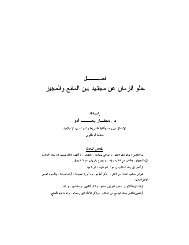Anderson's Winesburg, Ohio: The Individual in the Village Dr ...
Anderson's Winesburg, Ohio: The Individual in the Village Dr ...
Anderson's Winesburg, Ohio: The Individual in the Village Dr ...
You also want an ePaper? Increase the reach of your titles
YUMPU automatically turns print PDFs into web optimized ePapers that Google loves.
Damascus University Journal, Vol.٢٠, No. (١+٢), ٢٠٠٤<br />
Kutrieh<br />
Ahmad Ramez<br />
Endnotes<br />
١. <strong>The</strong> Boston Transcript makes this observation through <strong>the</strong> title of<br />
its review, "<strong>Ohio</strong> Small Town Life: Commonplace People and <strong>The</strong>ir<br />
Everyday Existence." (W.S.B. Boston Transcript, ١١ June ١٩١٩, p. ٦<br />
quoted <strong>in</strong> Ray Lewis White, Compiler. <strong>The</strong> Merrill Studies <strong>in</strong><br />
<strong>W<strong>in</strong>esburg</strong>, <strong>Ohio</strong>. Columbus, <strong>Ohio</strong>: Charles E. Merrill Publish<strong>in</strong>g Co.,<br />
١٩٧١, p.٣٠) Ano<strong>the</strong>r review that appeared <strong>in</strong> <strong>The</strong> New Republic is titled,<br />
"A Country Town." <strong>The</strong> reviewer f<strong>in</strong>ds that "<strong>the</strong> stories are homely and<br />
unsympa<strong>the</strong>tic" (M.A. "A Country Town" <strong>The</strong> New Republic, XIX(June<br />
٢٥, ١٩١٩), ٢٥٧, ٢٦٠ repr<strong>in</strong>ted <strong>in</strong> <strong>The</strong> Merrill Studies <strong>in</strong> <strong>W<strong>in</strong>esburg</strong>, <strong>Ohio</strong>,<br />
٣٦).<br />
٢. Many writers of <strong>the</strong> post civil war era looked at <strong>the</strong> village as a<br />
place where all citizens work <strong>in</strong> comfort and happ<strong>in</strong>ess. Positive images<br />
of <strong>the</strong> village are found, for example, <strong>in</strong> <strong>the</strong> works of Booth Tark<strong>in</strong>gton<br />
among o<strong>the</strong>rs. For <strong>the</strong> most part, <strong>the</strong>se writers presented <strong>the</strong> village as "a<br />
place of idyllic felicities"(٦٥٠). But <strong>the</strong> village is not presented this way<br />
<strong>in</strong> <strong>Anderson's</strong> book.<br />
٣. Horace Gregory, suggested that despite <strong>the</strong> fact <strong>the</strong> stories of<br />
<strong>W<strong>in</strong>esburg</strong> are "set <strong>in</strong> <strong>the</strong> remembered atmosphere of a small town <strong>in</strong><br />
America,” <strong>the</strong>y “have a "universal"quality," yet he f<strong>in</strong>ds <strong>the</strong> scene<br />
depicted to be close "to <strong>the</strong> roots of an American heritage . . ." (٤). Even<br />
<strong>in</strong> <strong>the</strong> eighties one scholar comments that "Critics have concentrated, for<br />
<strong>the</strong> most part, on <strong>the</strong> subject of small-town life <strong>in</strong> <strong>the</strong> Midwest . . . or<br />
isolation . . . " (Fludernik ١١٦).<br />
٤. Waldo Frank notes that <strong>the</strong> book has no happily married people,<br />
no communion with children, no fulfilled sex, no normal social life, no<br />
worship <strong>in</strong> congregation, no strength <strong>in</strong> organized religion, no joy, and no<br />
matur<strong>in</strong>g characters for <strong>the</strong> traditions and social structures on which <strong>the</strong><br />
world builds itself are lack<strong>in</strong>g <strong>in</strong> <strong>Anderson's</strong> town (٤٥).<br />
٥. Alan Steven Berkowitz suggests <strong>in</strong> his dissertation that Anderson<br />
explored <strong>the</strong> isolation, lonl<strong>in</strong>ess and failure hidden <strong>in</strong> <strong>the</strong> American<br />
village that gradually lost its agrarian values of charity and community.<br />
٦. David Anderson <strong>in</strong> “Ano<strong>the</strong>r Look at Community <strong>in</strong> <strong>W<strong>in</strong>esburg</strong>,<br />
<strong>Ohio</strong>” argues that Sherwood Anderson “focused on <strong>the</strong> failures of<br />
<strong>in</strong>dividuals to have <strong>the</strong>ir performances affirmed . . .”(٧٩). <strong>The</strong>se<br />
performances are “some sort of s<strong>in</strong>gularity”(٧٨).<br />
٤٩

















